人教版八年级英语下册第一单元教案
- 格式:doc
- 大小:55.99 KB
- 文档页数:15
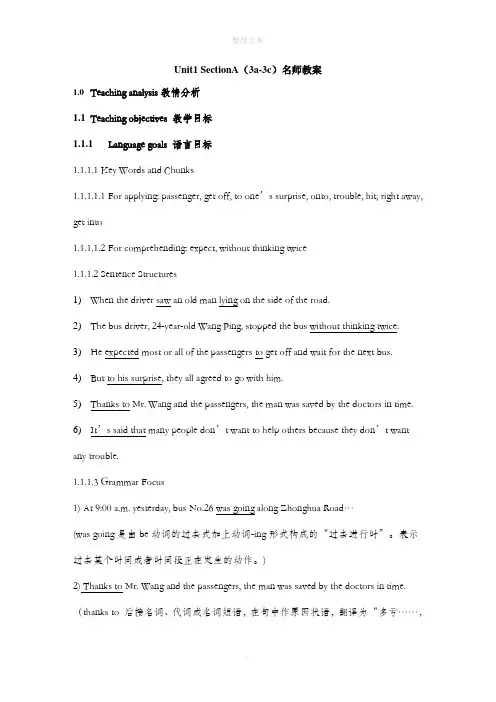
Unit1 SectionA(3a-3c)名师教案1.0Teaching analysis教情分析1.1Teaching objectives 教学目标1.1.1Language goals 语言目标1.1.1.1 Key Words and Chunks1.1.1.1.1 For applying: passenger, get off, to one’s surprise, onto, trouble, hit, right away, get into1.1.1.1.2 For comprehending: expect, without thinking twice1.1.1.2 Sentence Structures1)When the driver saw an old man lying on the side of the road.2)The bus driver, 24-year-old Wang Ping, stopped the bus without thinking twice.3)He expected most or all of the passengers to get off and wait for the next bus.4)But to his surprise, they all agreed to go with him.5)Thanks to Mr. Wang and the passengers, the man was saved by the doctors in time.6)It’s said that many people don’t want to help others because they don’t want any trouble.1.1.1.3 Grammar Focus1) At 9:00 a.m. yesterday, bus No.26 was going along Zhonghua Road…(was going是由be动词的过去式加上动词-ing形式构成的“过去进行时”。
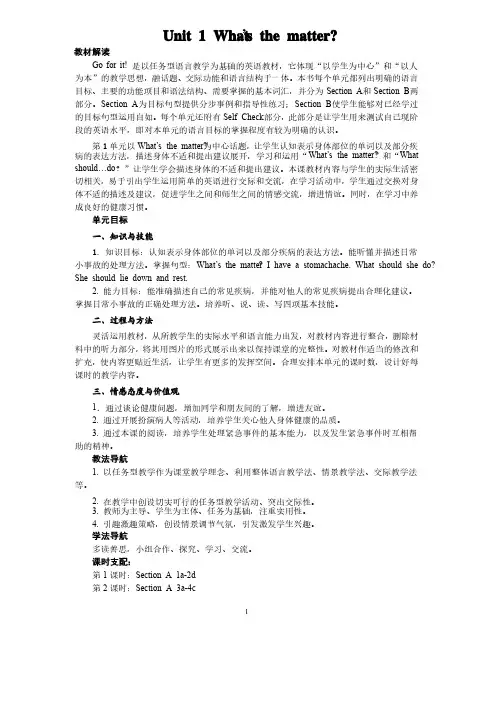
1 Unit 1 What’s the matter? 教材解读Go Go for for for it! it! 是以任务型语言教学为基础的英语教材,它体现“以学生为中心”和“以人为本”的教学思想,融话题、交际功能和语言结构于一体。
交际功能和语言结构于一体。
本书每个单元都列出明确的语言本书每个单元都列出明确的语言目标、主要的功能项目和语法结构、需要掌握的基本词汇,并分为Section A 和Section B 两部分。
Section A 为目标句型提供分步事例和指导性练习;Section B 使学生能够对已经学过的目标句型运用自如。
每个单元还附有Self Check 部分,此部分是让学生用来测试自己现阶段的英语水平,即对本单元的语言目标的掌握程度有较为明确的认识。
第1单元以What’s What’s the matter? the matter?为中心话题,为中心话题,让学生认知表示身体部位的单词以及部分疾病的表达方法,描述身体不适和提出建议展开,学习和运用“What’s What’s the matter? the matter?”和“”和“What should…do ”让学生学会描述身体的不适和提出建议。
?”让学生学会描述身体的不适和提出建议。
本课教材内容与学生的实际生活密本课教材内容与学生的实际生活密切相关,易于引出学生运用简单的英语进行交际和交流,易于引出学生运用简单的英语进行交际和交流,在学习活动中,在学习活动中,学生通过交换对身体不适的描述及建议,促进学生之间和师生之间的情感交流,体不适的描述及建议,促进学生之间和师生之间的情感交流,增进情谊。
同时,在学习中养增进情谊。
同时,在学习中养成良好的健康习惯。
单元目标一、知识与技能1. 1. 知识目标:认知表示身体部位的单词以及部分疾病的表达方法。
能听懂并描述日常知识目标:认知表示身体部位的单词以及部分疾病的表达方法。
能听懂并描述日常小事故的处理方法。
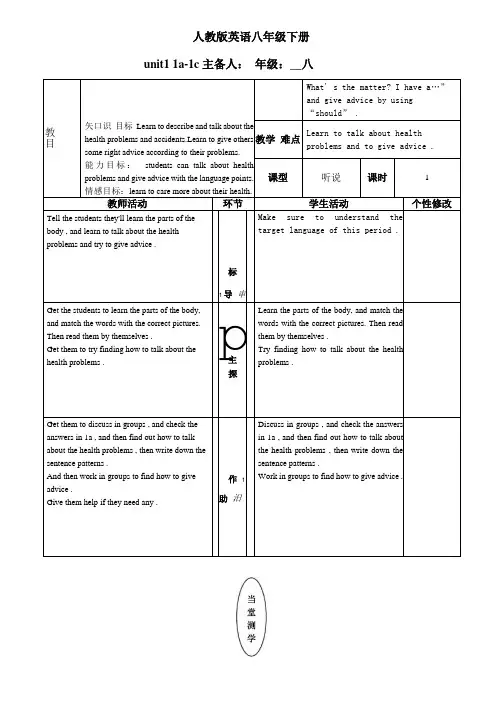
人教版英语八年级下册unit1 1a-1c 主备人:年级:__八学生课堂学习情况反馈教学反思学标教目矢口识目标Learn to describe and talk about the health problems and accidents.Learn to give others some right advice according to their problems.能力目标:students can talk about health problems and give advice with the language points.情感目标:learn to care more about their health.教师活动环节First have a dictation of the new words learned yesterday.Tell them they'll continue to learn how to talk about health problems and give advice .小标导J 审Ask the students to guess what 's the matter with the students in 2a .Then try to find the advice to differentproblems .Get them to translate the phrases . G 主探Play the recording and get them to finish 2a and 2b .Ask them to make conversations according to the listening material .1A作助 1审鬻What' s the matter? I have a…”and give advice by using“should” .教学难点Learn to talk about healthproblems and to give advice .课型听说课时 2学生活动个性修改Have a dictation of the new wordslearned yesterday.Go over the points learned yesterday .Guess what 's the matter with the studentsin 2a and write down .Find the advice to different problems .Translate the phrases .Finish 2a and 2b .Make conversations according to thelistening material .学生课堂学习情况反馈教学反思学科英语课题《unitl 2d , 4b》主备人:年级:__八学标教目知识目标:Learn to give others some right advice according to their problems.能力目标:Enable students to talk about health problems and give advice with the language points.情感目标:Students care more about themselves and their family members ' health.教师活动环节Tell them that they'll continue to learn how totalk about health problems and give advice.Today they'll learn a conversation and talkabout health problems.标1导刘Ask the students to read the dialogue bythemselves , underline the new words and thewords they don't know.Get them to answer the questions given by the teachers. G 主探Get them to work together and find out theanswers according to the conversation. Then role play the conversations. A作助旧教学重点Learn to talk about healthproblems by using “What' s thematter? I have a …” and giveadvice by using “should”.教学难点Learn to give appropriate adviceto the certain health problems.课型听说课时 3学生活动个性修改Continue to learn how to talk abouthealth problems and give advice.Learn a conversation and talk about health problems.Read the dialogue by themselves ,underline the new words and the wordsthey don't know.Answer the questions given by theteachers.work together and find out the answersaccording to the conversation.Then role play the conversations.学生课堂学习情况反馈教学反思学科英语课题《unit 1 grammar-4b》主备人:年级:_八学科英语课题《unitl section B 1a- 1c》主备人:年级:_八教学资源(含自编习题、阅读文章、听力资料、知识链接等)学科英语课题《unitl section B 2b-2e》主备人:_年级:_八学科英语课题《unitl self check》主备人:_年级:_八__。
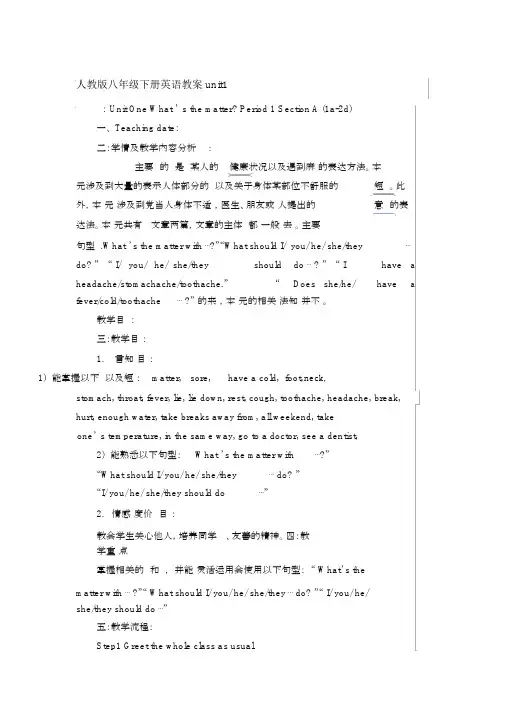
人教版八年级下册英语教案unit1: Unit One What ’ s the matter? Period 1 Section A (1a-2d)一、 Teaching date:二:学情及教学内容分析:主要的是某人的健康状况以及遇到麻的表达方法。
本元涉及到大量的表示人体部分的以及关于身体某部位不舒服的短。
此外,本元涉及到党当人身体不适,医生、朋友或人提出的意的表达法。
本元共有文章两篇,文章的主体都一般去。
主要句型 .What ’s the matter with ⋯?”“What should I/ you/ he/ she/they⋯do? ” “ I/ you/ he/ she/they should do ⋯ ? ” “ I have aheadache/stomachache/toothache.”“Does she/he/have afever/cold/toothache⋯ ?” 的来,本元的相关法知并不。
教学目 :三:教学目:1.言知目:1) 能掌握以下以及短:matter, sore, have a cold, foot,n eck,stomach, throat, fever, lie, lie down, rest, cough, toothache, headache, break,hurt, enough water, take breaks away from, all weekend, takeone’ s temperature, in the same way, go to a doctor, see a dentist,2) 能熟悉以下句型:What ’s the matter with⋯?”“What should I/ you/ he/ she/they⋯do?”“I/ you/ he/ she/they should do⋯”2.情感度价目:教会学生关心他人,培养同学、友善的精神。
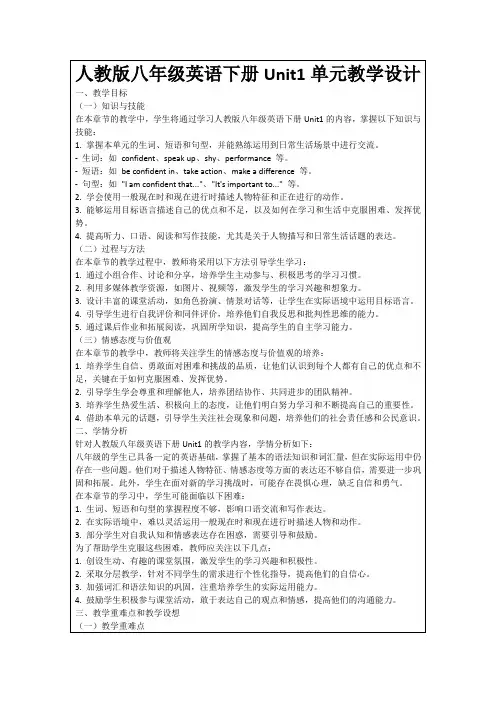
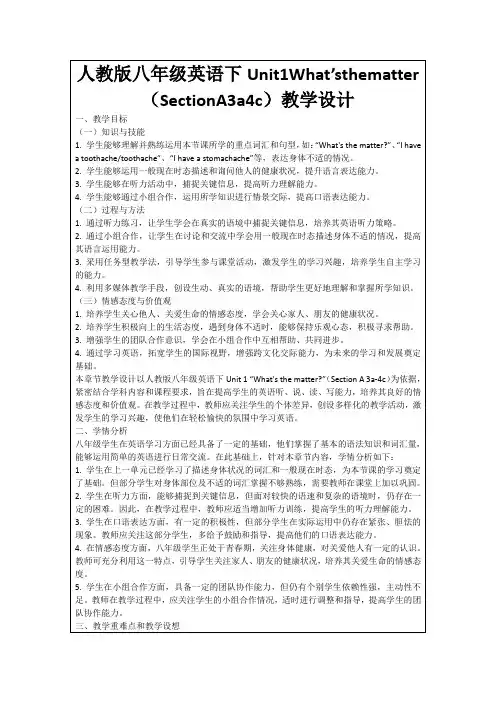
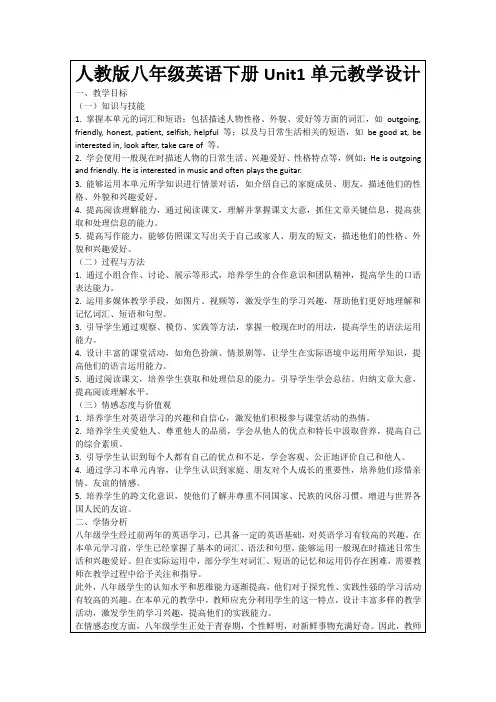
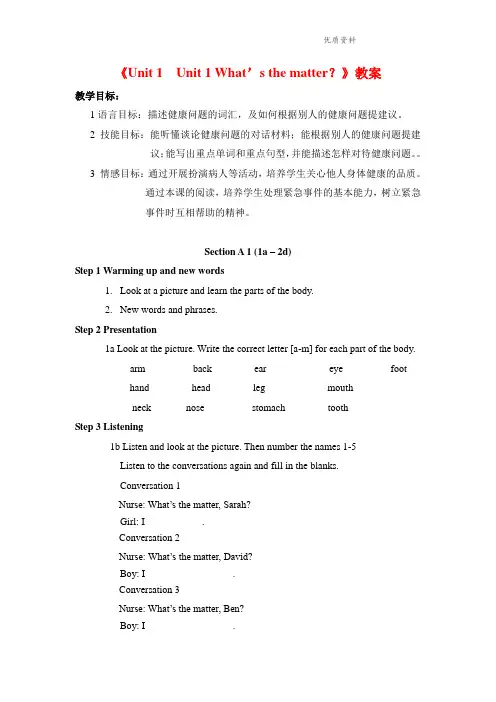
《Unit 1 Unit 1 What’s the matter?》教案教学目标:1语言目标:描述健康问题的词汇,及如何根据别人的健康问题提建议。
2 技能目标:能听懂谈论健康问题的对话材料;能根据别人的健康问题提建议;能写出重点单词和重点句型,并能描述怎样对待健康问题。
3 情感目标:通过开展扮演病人等活动,培养学生关心他人身体健康的品质。
通过本课的阅读,培养学生处理紧急事件的基本能力,树立紧急事件时互相帮助的精神。
Section A 1 (1a – 2d)Step 1 Warming up and new words1.Look at a picture and learn the parts of the body.2.New words and phrases.Step 2 Presentation1a Look at the picture. Write the correct letter [a-m] for each part of the body.___arm ___ back ___ ear ___ eye ___ foot___hand ___ head ___ leg ___ mouth___ neck ___nose ___ stomach ___ toothStep 3 Listening1b Listen and look at the picture. Then number the names 1-5Listen to the conversations again and fill in the blanks.Conversation 1Nurse: What’s the matter, Sarah?Girl: I ___________.Conversation 2Nurse: What’s the matter, David?Boy: I _________________.Conversation 3Nurse: What’s the matter, Ben?Boy: I _________________.Conversation 4Nurse: What’s the matter, Nancy?Girl: I _________________.Conversation 5Betty: What’s the matter, Judy?Ann: She __________________.Step 4 Speaking1c Look at the pictures. What are the students’ problems? Make conversati ons.ExamplesA: What’s the matter with Judy?B: She talked too much yesterday and didn’t drink enough water.She has a very sore throat now.A: What’s the matter with Sarah?B: She didn’t take care of herself on the weekend. She was p laying withher friends at the park yesterday. Then it got windy, but she didn’t puton her jacket. Now she has a cold.Step 5 Guessing gamesGuess what has happened to the students by using the important sentenc es. Step 6 Listening2a Listen and number the pictures [1-5] in the order you hear them.2b Listen again. Match the problems with the advice.Step 7 Speaking2c Make conversations using the information in 2a and 2bA: What’s the matter?B: My head feels very hot.A: Maybe you have a fever.B: What should I do?A: You should take your temperature.Step 8 Role–playImagine you are the school doctor. A few students have health problems.Role-play a conversation between the doctor and the students.2d Role –play the conversationStep 9 Language points and summary1. What’s the matter?这是人们特别是医生和护士询问病人病情时最常用的问句, 意思是“怎么了?”其后通常与介词with连用。
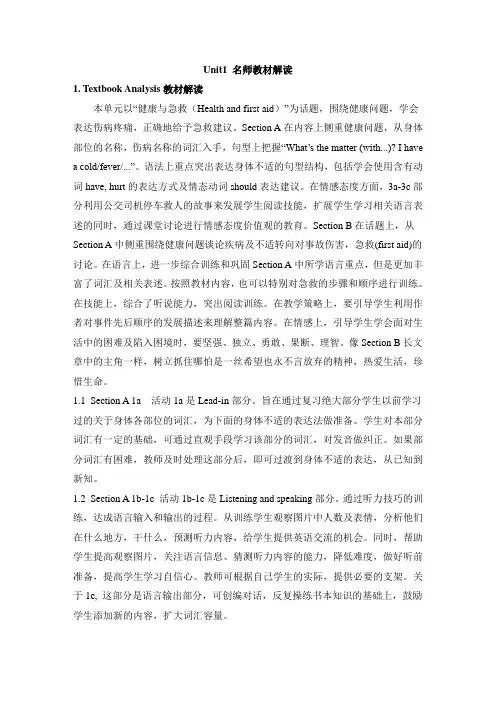
Unit1 名师教材解读1. Textbook Analysis教材解读本单元以“健康与急救(Health and first aid)”为话题,围绕健康问题,学会表达伤病疼痛,正确地给予急救建议。
Section A在内容上侧重健康问题,从身体部位的名称,伤病名称的词汇入手,句型上把握“What’s the matter (with...)? I have a cold/fever/...”。
语法上重点突出表达身体不适的句型结构,包括学会使用含有动词have, hurt的表达方式及情态动词should表达建议。
在情感态度方面,3a-3c部分利用公交司机停车救人的故事来发展学生阅读技能,扩展学生学习相关语言表述的同时,通过课堂讨论进行情感态度价值观的教育。
Section B在话题上,从Section A中侧重围绕健康问题谈论疾病及不适转向对事故伤害,急救(first aid)的讨论。
在语言上,进一步综合训练和巩固Section A中所学语言重点,但是更加丰富了词汇及相关表述。
按照教材内容,也可以特别对急救的步骤和顺序进行训练。
在技能上,综合了听说能力,突出阅读训练。
在教学策略上,要引导学生利用作者对事件先后顺序的发展描述来理解整篇内容。
在情感上,引导学生学会面对生活中的困难及陷入困境时,要坚强、独立、勇敢、果断、理智。
像Section B长文章中的主角一样,树立抓住哪怕是一丝希望也永不言放弃的精神,热爱生活,珍惜生命。
1.1Section A 1a 活动1a是Lead-in部分。
旨在通过复习绝大部分学生以前学习过的关于身体各部位的词汇,为下面的身体不适的表达法做准备。
学生对本部分词汇有一定的基础,可通过直观手段学习该部分的词汇,对发音做纠正。
如果部分词汇有困难,教师及时处理这部分后,即可过渡到身体不适的表达,从已知到新知。
1.2Section A 1b-1c 活动1b-1c是Listening and speaking部分。
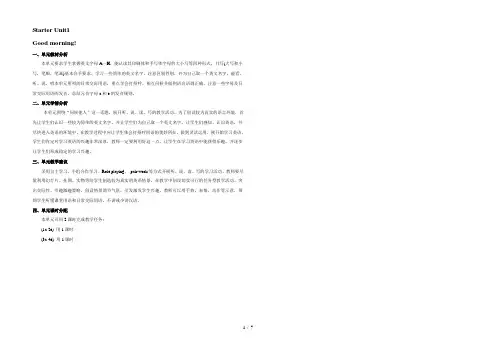
Starter Unit1Good morning!一、单元教材分析本单元要求学生掌握英文字母A—H,能认读其印刷体和手写体字母的大小写等四种形式。
书写(大写和小写,笔顺,笔画)基本合乎要求。
学习一些简单的英文名字,注意区别性别,并为自己取一个英文名字。
能看、听、说、唱本单元所列的日常交际用语,重点学会打招呼、相互问候并做到语音语调正确。
注意一些字母及日常交际用语的发音,总结元音字母a和e的发音规则。
二、单元学情分析本单元围绕“问候他人”这一话题,展开听、说、读、写的教学活动。
为了创设较为真实的语言环境,首先让学生们认识一些较为简单的英文名字,并让学生们为自己取一个英文名字,让学生们感知、认识英语,并尽快进入英语的环境中。
在教学过程中应让学生体会打招呼用语的奥妙所在,做到灵活运用。
刚开始学习英语,学生们肯定对学习英语的兴趣非常深厚,教师一定要利用好这一点,让学生在学习英语中能获得乐趣。
并逐步让学生们形成稳定的学习兴趣。
三、单元教学建议采用自主学习、小组合作学习、Role playing、pair work等方式开展听、说、读、写的学习活动。
教师要尽量利用幻灯片、挂图、实物等给学生创造较为真实的英语情景。
在教学中创设切实可行的任务型教学活动、突出交际性。
引趣激趣策略,创设情景调节气氛,引发激发学生兴趣。
教师可以用手势,表情,动作等示意,帮助学生听懂课堂用语和日常交际用语,不讲或少讲汉语。
四、单元课时分配本单元可用2课时完成教学任务:(1a-2e) 用1课时(3a-4d) 用1课时(1a-2d)一、教学目标:1. 语言知识目标:1) 能掌握以下词汇:字母Aa ~ Hh, good, morning, Good morning!, hi, hello2) 能掌握以下句型:①Good morning, Helen!②Hello, Frank!③Hi, Bob!3) 能理解用英语打招呼的不同说法,并能灵活运用。
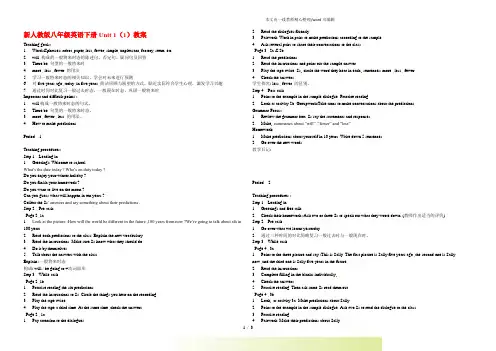
新人教版八年级英语下册Unit 1(1)教案Teaching goals:1. Words&phrases: robot, paper, less, fewer, simple, unpleasant, factory, seem, etc .2. will 构成的一般将来时态的陈述句、否定句、疑问句及回答.3. There be 句型的一般将来时.4. more , less , fewer 的用法.5. 学习一般将来时态的相关知识,学会对未来进行预测.6. 对five years ago ,today ,in five years 简洁回顾与展望的方式,贴近实际符合学生心理,激发学习兴趣.7. 通过时间对比复习一般过去时态、一般现在时态,巩固一般将来时.Important and difficult points :1. will构成一般将来时态的句式。
2. There be 句型的一般将来时态。
3. more , fewer , less 的用法。
4. How to make predictions .Period 1Teaching procedures:Step 1 Leading in1. Greetings: Welcome to sc hool .What’s the date today ? Who’s on duty today ?Do you enjoy your winter holiday ?Do you finish your homework ?Do you want to live on the moon ?Can you guess what will happen in ten years ?Collect the Ss’ answers and say something about their predictions .Step 2 Pre-taskPage 2 ,1a .1. Look at the picture :How will the world be different in the future ,100 years from now ?We’re going to talk about sth in 100 years .2. Read each predictions to the class .Explain the new vocabulary .3. Read the instructions .Make sure Ss know what they should do .4. Do it by themselves .5. Talk about the answers with the class .Explain :一般将来时态构成: will / be going to +动词原形Step 3 While-taskPage 2 ,1b .1. Practise reading the six predictions .2. Read the instructions to Ss .Circle the things you hear on the recording .3. Play the tape twice .4. Play the tape a third time .At the same time ,check the answers .Page 2 , 1c .1. Pay attention to the dialogues .2. Read the dialogues fluently .3. Pairwork .Work in pairs to make predictions according to the sample .4. Ask several pairs to share their conversations to the class .Page 3 , 2a & 2b .1. Read the predictions .2. Read the instructions and point out the sample answer .3. Play the tape twice .Ss circle the word they hear in each sentences: more , less , fewer .4. Check the answers .学生探究: less , fewer 的区别。
人教版八年级英语下册《Unit1 what’s the matter》教学设计(第1课时)一. 教材分析人教版八年级英语下册《Unit1 What’s the matter?》主要讲述了询问和描述人们身体状况和情感状态的话题。
通过本节课的学习,学生将能够掌握相关词汇和表达方式,提高在日常生活中的英语交际能力。
本节课的主要内容包括询问某人怎么了,描述身体不适和情感状态,以及给出相应的建议。
二. 学情分析八年级的学生已经具备了一定的英语基础,能够听懂并运用一些基本的英语口语。
然而,学生在描述身体状况和情感状态方面的词汇积累还不够丰富,需要通过本节课的学习来加以拓展。
此外,学生对于日常英语交际中的表达方式还不够熟练,需要通过大量的操练来提高。
三. 教学目标1.知识目标:学生能够掌握询问和描述身体状况和情感状态的相关词汇和表达方式。
2.能力目标:学生能够在日常生活中运用所学知识进行简单的英语交际。
3.情感目标:学生能够关心他人,学会用英语询问并关心他人的身体状况和情感状态。
四. 教学重难点1.重点:学生能够掌握询问和描述身体状况和情感状态的相关词汇和表达方式。
2.难点:学生能够在实际情景中熟练运用所学知识进行英语交际。
五. 教学方法1.情境教学法:通过设置各种生活情境,让学生在实际语境中学习并运用所学知识。
2.任务型教学法:通过完成各种任务,引导学生主动参与课堂,提高英语交际能力。
3.小组合作学习:通过小组讨论和互动,激发学生的学习兴趣,培养团队合作精神。
六. 教学准备1.教学PPT:制作包含本节课主要内容和相关情境的PPT。
2.教学素材:准备一些描述身体状况和情感状态的图片或卡片。
3.教学录音设备:用于播放听力材料。
七. 教学过程1.导入(5分钟)教师通过播放一段关于人们描述身体状况和情感状态的听力材料,引导学生关注本节课的主题。
同时,教师可以提问学生:“Can you guess what’s the matter with them?”,激发学生的学习兴趣。
人教版八年级下册英语第一单元教学设计全文共10篇示例,供读者参考篇1Title: My Lesson Plan for Unit 1 of Grade 8 EnglishHello everyone! Today I am going to share with you my super fun lesson plan for Unit 1 of Grade 8 English. Are you ready? Let's get started!1. Warm-up (10 minutes)To start off the lesson, we will play a quick game of "Simon Says" to review some vocabulary from the previous unit. I will say words like "apple" or "book" and you have to do the action if I say "Simon says". This will get our brains warmed up and ready to learn!2. Vocabulary Introduction (20 minutes)Next, we will learn some new words related to the unit theme of "My hobbies". I will use flashcards and pictures to help you understand the meanings of words like "painting", "dancing", and "swimming". We will practice saying the words and make sentences using them.3. Reading Activity (30 minutes)Now it's time for some reading practice! I will read a short passage about different hobbies and you will listen carefully. After that, we will discuss the main ideas of the passage and answer some questions to check our understanding. This will help us improve our reading skills.4. Speaking Practice (20 minutes)In this activity, we will work in pairs to talk about our own hobbies. You will ask your partner questions like "What do you like to do in your free time?" and "Why do you enjoy that hobby?". This will help us practice speaking in English and improve our communication skills.5. Writing Task (20 minutes)For our writing task, you will write a short paragraph about your favorite hobby. Use the new vocabulary words we learned earlier and try to make your writing interesting and creative. Don't forget to include reasons why you enjoy that hobby!6. Review and Wrap-up (10 minutes)To end the lesson, we will review the key points we learned today and do a quick quiz to see how much you remember. I willalso give you some homework to practice at home. Remember, practice makes perfect!I hope you enjoyed my lesson plan for Unit 1 of Grade 8 English. Let's keep working hard and improving our English skills together! Thank you for listening and see you next time! Bye bye!篇2Hello everyone! Today I am going to share with you the teaching design for the first unit of the Eighth Grade English textbook from People's Education Press.First, let's talk about the objectives of this unit. By the end of the unit, students should be able to introduce themselves and others, talk about likes and dislikes, and ask and respond to questions about hobbies and interests.To achieve these objectives, I have planned the following activities:1. Warm-up activity: I will start the lesson with a fun icebreaker activity where students will introduce themselves using simple English phrases like "My name is..." and "I am from...". This will help create a positive and interactive learning atmosphere.2. Vocabulary building: I will introduce key vocabulary related to hobbies and interests such as "reading, swimming, playing basketball, listening to music, etc." Students will practice pronouncing and using these words in sentences.3. Listening and speaking practice: I will play a recording of different people talking about their hobbies and interests. Students will listen and answer questions related to the recording. Then, they will work in pairs to interview each other about their hobbies.4. Reading comprehension: I will distribute a short passage about a student's favorite hobby. Students will read the passage and answer comprehension questions to check their understanding.5. Writing task: Students will write a short paragraph about their own hobbies and interests. They will then share their paragraphs with the class to practice speaking in front of others.6. Group discussion: In groups, students will discuss and share their favorite hobbies and interests. They will also talk about common interests they have with their classmates.7. Review and assessment: At the end of the unit, I will give students a quiz to test their understanding of the vocabulary andgrammar covered in the unit. I will also ask them to present a short skit where they introduce themselves and talk about their hobbies.I hope this teaching design will help students learn and practice English in a fun and engaging way. Let's work hard and improve our English skills together!篇3Hey guys! Today we're going to talk about the first unit in the eighth grade English textbook. It's all about "My Day". I'm so excited to teach you all about it!First, we'll start with the key vocabulary words. We have things like "morning", "afternoon", "evening", and "night". These are all important words to describe different times of the day. We'll also learn about activities we do during each of these times, like "get up", "have breakfast", "go to school", "do homework", and "go to bed".Next, we'll practice using these words in sentences. For example, "I get up in the morning and have breakfast". Or "I go to school in the afternoon and do homework in the evening". Try to make your own sentences using these words!Then, we'll move on to grammar. We'll learn about the simple present tense and how to use it correctly. Remember to use the base form of the verb for most subjects, like "I", "you", "we", and "they". But don't forget to add an "s" to the verb for subjects like "he", "she", and "it".Finally, we'll do some fun activities to practice what we've learned. We can play games, do role plays, or even make a daily schedule for ourselves. It will be a lot of fun!I hope you're all as excited as I am to learn about "My Day". Let's have a great time learning together!篇4Hello everyone! Today I'm going to talk about our first unit in the Grade 8 English textbook. It's called "A new start".First, we will learn some new words like ambition, curious, survive, communicate, etc. We can use flashcards or games to help us remember them.Next, we will learn the grammar rules. In this unit, we will focus on the past simple tense and how to form questions and negative sentences using it. We can practice by makingsentences about our weekend activities or what we did during the holidays.Then, we will read a text about a girl named Sarah who moves to a new city and tries to adapt to her new surroundings. We will discuss the main idea and key details of the text and talk about how Sarah overcomes her challenges.After that, we will work on our speaking and listening skills by doing some role play activities. We can pretend to be Sarah and her new friends and have conversations about our interests and hobbies.Finally, we will do some writing tasks where we can write about our own ambitions and goals for the future. We can also write a short story using the past simple tense.I hope you're all excited to start this new unit with me. Let's work hard and have fun learning English together!篇5Hello everyone! Today, I’m going to share with you my teaching plan for the first unit of the eighth grade English textbook. Let’s dive in!First off, we will start the lesson by introducing the topic of the unit, which is “School Life”. We will ta lk about different school subjects, daily routines, and school activities. I will use pictures, videos, and real-life examples to make the lesson more interesting and engaging.Next, we will focus on key vocabulary and grammar points in the unit. We will learn how to talk about our school subjects, describe our daily routines, and express our likes and dislikes. I will use games, role-plays, and group activities to help reinforce the new vocabulary and grammar structures.After that, we will work on listening and speaking skills. We will listen to dialogues, watch videos, and practice speaking exercises to improve our communication skills. I will also encourage students to work in pairs or small groups to practice speaking in a more interactive way.Then, we will move on to reading and writing activities. We will read short passages about school life, answer comprehension questions, and write short paragraphs about our own school experiences. I will provide feedback and guidance to help students improve their reading and writing skills.Finally, we will review and assess what we have learned in the unit. We will play review games, complete worksheets, and take aquiz to test our knowledge. I will also encourage students to reflect on their learning and set goals for improvement.Overall, my teaching plan for the first unit of the eighth grade English textbook is designed to be fun, interactive, and engaging. I hope that by the end of the unit, all students will have improved their English skills and gained a deeper understanding of school life. Thank you for listening and let’s have a great lesson together!篇6Design of the first unit in Grade 8 of the People's Education Press EnglishHi everyone, I'm going to tell you about the teaching plan for the first unit in Grade 8 of the People's Education Press English! This unit is all about "School Life", so let's get started!First, we will start by introducing the new vocabulary words like "homework", "classmate", and "schedule". We can play games like bingo or charades to help us remember these words.Next, we will practice using these words in sentences by doing some activities like matching pictures with words or fillingin the blanks. We can also do some role-playing exercises where we act out different school situations using the new vocabulary.After that, we will move on to grammar and focus on the present simple tense. We will learn about how to form positive, negative, and question sentences using this tense. We can practice by writing sentences about our daily routines and then sharing them with the class.Finally, we will work on our listening and speaking skills by listening to dialogues and answering questions about them. We can also practice speaking by doing pair work activities where we ask and answer questions about our school lives.In the end, we will have a review session where we can play games or do some fun activities to help us remember everything we have learned in this unit.I hope you guys are excited to start learning about "School Life" in Grade 8! Let's have a great time learning together!篇7Hello everyone! Today I'm going to share with you a super fun lesson plan for the first unit of Grade 8 English textbook by People's Education Press. Are you ready? Let's get started!1. Warm-up activities (10 minutes)To start off the lesson, let's do a quick warm-up activity. We can play a game of vocabulary charades, where one student acts out a word from the unit vocabulary list while the rest of the class tries to guess what it is. This will help get everyone excited and engaged for the lesson.2. Introduction to the unit (15 minutes)Next, let's introduce the theme of the unit, which is about traveling. We can show a short video clip of different modes of transportation and famous landmarks around the world. This will help students understand the context of the unit and get them interested in learning more about different cultures.3. Reading and comprehension (20 minutes)Now it's time to dive into the reading passage for this unit. We can have students read the passage individually or in pairs, and then discuss comprehension questions as a class. This will help students practice their reading skills and improve their understanding of the text.4. Vocabulary practice (15 minutes)After reading the passage, let's do some vocabulary practice. We can play a matching game where students match words fromthe unit vocabulary list with their definitions. This will help reinforce new words and concepts learned in the reading passage.5. Grammar focus (20 minutes)In this unit, the grammar focus is on using the present perfect tense. Let's do some exercises together to practice forming sentences in the present perfect tense. We can also have students write short paragraphs using the present perfect tense to describe their own travel experiences.6. Speaking activity (15 minutes)To wrap up the lesson, let's do a speaking activity where students can practice using the vocabulary and grammar structures learned in this unit. We can have students pair up and take turns asking each other questions about their favorite travel destinations, using the present perfect tense.7. Homework assignment (5 minutes)Lastly, let's assign a homework task for students to complete before the next lesson. This can be a writing assignment where students write a short essay about their dream vacation using the vocabulary and grammar structures learned in this unit.I hope you enjoyed this lesson plan for the first unit of Grade8 English textbook. Have fun learning and exploring the world of travel! See you next time!篇8Hello everyone, my name is Lily and today I'm going to share with you the teaching plan for Unit 1 of the Eighth Grade English textbook in the People's Education Edition.First, we will start the lesson by introducing the new vocabulary words such as culture, custom, behavior, etc. We can use flashcards or pictures to help students understand the meaning of these words better.Next, we will move on to the grammar points in this unit. We will focus on the past continuous tense and how to use it in sentences. We can give students some examples and ask them to make their own sentences using the past continuous tense.After that, we will discuss the reading passage in the textbook. We will read the passage together as a class and then ask students some comprehension questions to check their understanding. We can also ask students to summarize the main idea of the passage in their own words.For the speaking practice, we can set up role-play activities where students can act out different scenarios related to the topic of the unit. This will help students improve their speaking skills and also apply what they have learned in a real-life situation.Finally, we will end the lesson by giving students a short quiz to assess their understanding of the unit. This will help us identify any areas that need further clarification or review.I hope you find this teaching plan helpful and that your students enjoy learning English in a fun and interactive way. Thank you for listening!篇9Unit 1: School LifeHey friends! Today we're gonna talk about the first unit in our English textbook, "School Life". It's gonna be super cool and fun!First, we're gonna learn some new words like "classroom", "teacher", "homework", "test", and "friend". These words are super important for us to talk about our school life.Next, we're gonna learn some grammar rules like present simple tense, past simple tense, and future tense. We need to know how to use these tenses to talk about our daily routines, past events, and future plans.After that, we're gonna do some reading and listening exercises to improve our reading and listening skills. We'll read some stories about school life and listen to some conversations between classmates.Then, we're gonna do some speaking and writing activities to practice our speaking and writing skills. We'll talk about our school life, our favorite subjects, and our school activities. We'll also write some compositions about our school life and our future dreams.In the end, we're gonna have a unit test to see how much we've learned in this unit. Don't worry, we've been studying hard and we're gonna do great!So get ready to have some fun learning about school life in this unit. Let's do our best and have a blast! Let's go!篇10Unit 1 Making New FriendsHey guys! Today I’m going to share with you the teaching plan for the first unit of our 8th grade English textbook. This unit is all about making new friends, so get ready to learn how to introduce yourself and start conversations with people.Lesson 1: Greetings and IntroductionsIn this lesson, we will learn how to greet people and introduce ourselves. We will practice saying “Hello, my name is…” and “Nice to meet you.” We will also learn some common questions to ask when meeting someone new. At the end of the lesson, we will do a role play where we introduce ourselves to a new friend.Lesson 2: Hobbies and InterestsIn this lesson, we will talk about our hobbies and interests. We will learn how to ask “What do you like doing in your free time?” and h ow to respond with our own hobbies. We will have a discussion in pairs about our favorite activities and interests. We will also learn how to invite someone to do something together.Lesson 3: Making PlansIn this lesson, we will learn how to make plans with our friends. We will practice using phrases like “Let’s hang out thisweekend” and “What time works for you?” We will also learn how to accept or decline an invitation politely. At the end of the lesson, we will plan a group outing together.I hope you guys are excited to start making new friends and practicing your English skills! Remember to speak up and participate in the activities. Let’s have fun learning together!。
Unit 1 What's the matter?第一课时Section A (1a2d)【教学目标】1.重点单词:matter,back,sore,throat,stomachache,foot,neck,stomach,fever,lie,rest,cough,Xray,toothache,headache2 重点短语:have a sore throat,have a stomachache,have a cold,lie down,take one's temperature,have a fever,go to a doctor3 重点句式:—What's the matter?—She talked too much yesterday and didn't drink enough water.She has a very sore throat now.You should drink some hot tea with honey.It doesn't sound like you have a fever.You need to take breaks away from the computer.I think I sat in the same way for too long without moving.If your head and neck still hurt tomorrow,then go to a doctor.【学习重点】1 重点短语和句型2 询问对方身体状况的句型及答语【学习难点】询问对方身体状况的句型及答语【自主学习】一、预习课本P12新单词并背诵,完成下面的汉译英。
1 问题____________ 2.背部____________3 疼痛的____________ 4.嗓子____________5 胃痛____________ 6.脚____________7 脖子____________ 8.胃____________9 发烧____________ 10.平躺____________11 休息____________ 12.咳嗽____________13 X光____________ 14.牙疼____________15 头疼____________二、认真预习1a2d找出下列短语和句型。
Unit1 What's the matter?1. KnowledgeWords: have, cold, back, arm, ear, eye, foot, hand, head, leg, mouth, neck, nose, tooth, fever, rest, should, headache, ago, so, illness, thirsty, early, problem, way, traditional, believe, weak, angry, medicine, western, everybody, get, few, stay, important, moment, late, until, yesterday, hearPhrases: have a cold, be stressed out, a few, at the moment Structures: Have for talking about health problems.Modal: should / shouldn 't2. SkillsTalk about your health.Give advice.3. Learning Strategies Using what you know. Inferring content.II. BackgroundIII. Teaching Time: Six PeriodsPeriod OneTeaching Aims:1. Learn and master the following words and phrases: matter, have, cold, have a cold, stomachache, sore, back, arm, ear, foot, hand, head, leg, mouth, neck, nose, stomach, tooth, throat2. Develop the students'listening ability.3. Be able to talk about health.4. Sentence PatternsWhat 's the matter? I have a sore throat.Teaching Difficult Point The sentence patterns.Teaching Methods Listening practice to train the students 'listening ability.PairwrokTeaching AidsSome pictures.A tape recorder. Teaching ProceduresStep I Greetings.Step II. 1aTeach the students to study the new words by showing some pictures.eye, nose, mouth, ear, tooth, face, head, neck, back, stomach, arm, hand, leg, footAsk a student to read the list of thirteen names of body parts.Then let the students look at the picture and write the correct letter for each part of the body. Check the answers. Answers:k arm c back g ear i eye m foot a hand l head b leg f mouth e tooth d neck j nose h stomach Step III 1bShow some illnesses.e.g. I have a cold. I have a stomachache. Let several students say some illnesses.Ask a student to read the names. Nancy, Sarah, David, Ben, JudyThen play the recording the first time. Students only listen. Play the recording a second time. Students number the names. Cheek the answersAnswers:Nancy = 3 Sarah = 1 David = 2 Ben = 5 Judy = 4Step IV 1cAsk two students to read the conversation.A: What 's the matter?B: I have a sore throat.Then let the students make conversations in pairs.After some minutes, ask several pairs to say their conversations.Explain the language points.1. What 's the matter? 你怎么啦?这句话在口语中很常见,当别人遇到什么麻烦,或身体不舒服,你就可以问What ' the matter?意思是你怎么啦?/ 你遇到什么麻烦啦?/ 你哪儿不舒服?还可以在句末用介词with 表示对象。
)))))))))Unit 1 What's the matter?教材解读Go for it! 是以任务型语言教学为基础的英语教材,它体现“以学生为中心”和“以人为本”的教学思想,融话题、交际功能和语言结构于一体。
本书每个单元都列出明确的语言目标、主要的功能项目和语法结构、需要掌握的基本词汇,并分为Section A和Section B两部分。
Section A为目标句型提供分步事例和指导性练习;Section B使学生能够对已经学过的目标句型运用自如。
每个单元还附有Self Check部分,此部分是让学生用来测试自己现阶段的英语水平,即对本单元的语言目标的掌握程度有较为明确的认识。
第1单元以What's the matter?为中心话题,让学生认知表示身体部位的单词以及部分疾病的表达方法,描述身体不适和提出建议展开,学习和运用“What's the matter?”和“What should…do?”让学生学会描述身体的不适和提出建议。
本课教材内容与学生的实际生活密切相关,易于引出学生运用简单的英语进行交际和交流,在学习活动中,学生通过交换对身体不适的描述及建议,促进学生之间和师生之间的情感交流,增进情谊。
同时,在学习中养成良好的健康习惯。
单元目标一、知识与技能1. 知识目标:认知表示身体部位的单词以及部分疾病的表达方法。
能听懂并描述日常小事故的处理方法。
掌握句型:What's the matter? I have a stomachache. What should she do?She should lie down and rest.2. 能力目标:能准确描述自己的常见疾病,并能对他人的常见疾病提出合理化建议。
掌握日常小事故的正确处理方法。
培养听、说、读、写四项基本技能。
二、过程与方法灵活运用教材,从所教学生的实际水平和语言能力出发,对教材内容进行整合,删除材料中的听力部分,将其用图片的形式展示出来以保持课堂的完整性。
对教材作适当的修改和扩充,使内容更贴近生活,让学生有更多的发挥空间。
合理安排本单元的课时数,设计好每课时的教学内容。
三、情感态度与价值观1.通过谈论健康问题,增加同学和朋友间的了解,增进友谊。
2. 通过开展扮演病人等活动,培养学生关心他人身体健康的品质。
3. 通过本课的阅读,培养学生处理紧急事件的基本能力,以及发生紧急事件时互相帮助的精神。
教法导航1. 以任务型教学作为课堂教学理念、利用整体语言教学法、情景教学法、交际教学法等。
2. 在教学中创设切实可行的任务型教学活动、突出交际性。
3. 教师为主导、学生为主体、任务为基础,注重实用性。
4. 引趣激趣策略,创设情景调节气氛,引发激发学生兴趣。
学法导航多读善思,小组合作、探究、学习、交流。
课时支配:第1课时:Section A 1a-2d第2课时:Section A 3a-4c)))))))))).)))))))))第3课时:Section B 1a-2e第4课时:Section B 3a-Self Check课时教案第1课时Section A 1a-2d教学目标一、知识与技能1. 熟练读出,拼写本节课的表示身体部位的单词。
2. 能听懂健康问题及解决建议。
3. 掌握常见的询问健康的问题及答语。
二、过程与方法看图法,对话,做游戏,多种方法并用,促使学生主动探求知识。
三、情感态度与价值观通过学习本课,培养学生关心自己和他人的健康,增进彼此间的友谊。
教学重点学会询问并回答有关健康的问题,并能给出合理的建议。
教学难点掌握重点句型:What's the matter? I have a fever. You should take your temperature.教法导航通过看图、听录音、对话、讨论等方法学习谈论健康及提出建议。
学法导航通过看、听、说等各种途径,以小组合作的形式,主动探求知识,锻炼自主学习能力。
教学准备图片,多媒体。
教学过程Step 1 Warming up and new wordsLook at a picture and learn the parts of the body. Then show the words on the screen. Ask the students to read and remember them.Step 2 Presentation1a Look at the picture. Write the correct letter [a-m] for each part of the body.___arm ___ back ___ ear ___ eye ___ foot___hand ___ head ___ leg ___ mouth___ neck ___nose ___ stomach ___ toothStep 3 GameAsk all the students to stand up and play a game:The teacher says “head”,then all the students should point at their heads. Then the teacher says other parts of the body. After several times,ask some students to say and the rest students to do the actions.Step 4 Listening)))))))))).)))))))))1b Listen and look at the picture. Then number the names 1-5.Listen to the conversations again and fill in the blanks.Conversation 1Nurse:What's the matter,Sarah?Girl:I ___________.Conversation 2Nurse:What's the matter,David?Boy:I _________________.Conversation 3Nurse:What's the matter,Ben?Boy:I _________________.Conversation 4Nurse:What's the matter,Nancy?Girl:I _________________.Conversation 5Betty:What's the matter,Judy?Ann:She __________________.Step 5 Speaking1c Look at the pictures. What are the students' problems? Make conversations like this:A:What's the matter with Judy?B:She talked too much yesterday and didn't drink enough water. She has a very sore throat now.Make up dialogues about the students' problems after the example.Step 6 Guessing gamesGuess what has happened to the students by using the important sentences.Step 7 Listening2a Listen and number the pictures [1-5] in the order you hear them.2b Listen again. Match the problems with the advice.Step 8 Speaking2c Make conversations using the information in 2a and 2b.A:What's the matter?B:My head feels very hot.A:Maybe you have a fever.B:What should I do?A:You should take your temperature.Step 9 Role–playImagine you are the school doctor. A few students have health problems. Role-play aconversation between the doctor and the students.2d Role –play the conversationStep 10 Language points and summary1. What's the matter?这是人们特别是医生和护士询问病人病情时最常用的问句,意思是“怎么了?”其后通常与介词with连用。
类似的问句还有:What's wrong? 怎么啦?)))))))))).)))))))))What's wrong with you? 你怎么了?What's your trouble? 你怎么了?What's the trouble with you? 你怎么了?What's up? 你怎么了?2. have a cold 伤风,感冒,是固定词组。
表示身体不适的常用词组还有:have a bad cold 重感冒,have a fever发烧,have aheadache 头痛,have a stomachache 胃痛,have a toothache牙痛,have a backache背疼,havea sore throat喉咙疼3. 针对身体不适常提的建议:lie down and rest躺下并且休息,drink hot tea with honey喝热蜂蜜茶,drink lots of water喝大量水,see a dentist看牙医,take one's temperature量体温,go to a doctor看医生.Step 11 HomeworkMake up a conversation between a doctor and a patient.课堂作业翻译下列句子。